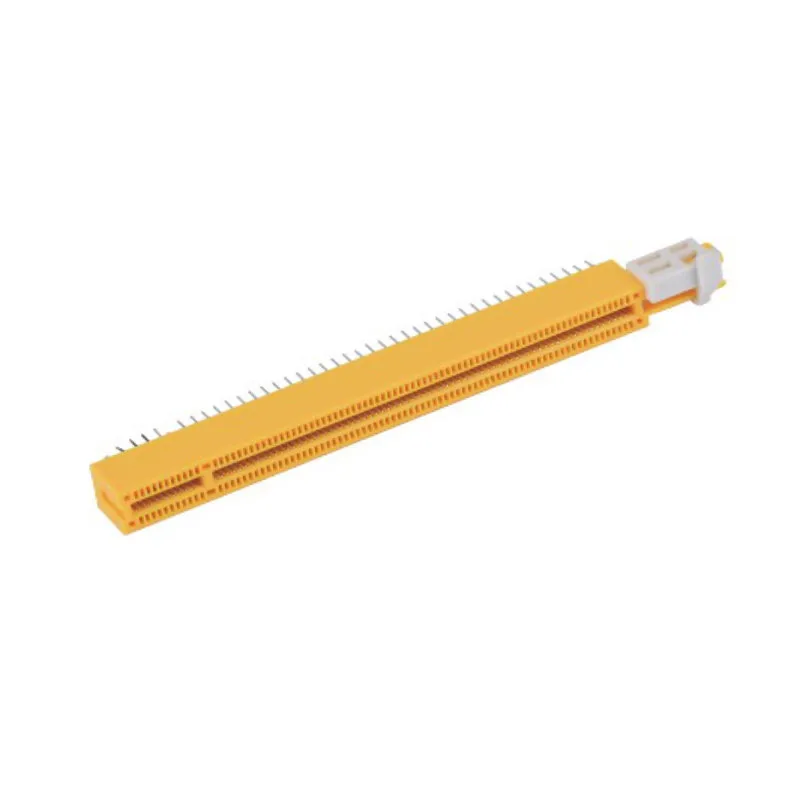

PCI Express Connector 164P Clamping Plate Type with Central Buckle card edge connector
- Part No : PCIEV10-164-RK-YL card edge connector
-
Current Rating:3.0Amps
Rating Voltage:250VAC A
Insulation Resistance:100M Ohm Min At DC500V
Contact Resistance:30m Ohm MaxAt DC100m Amps
Withstandina Voltaae:1 Minute At750V r.ms Min
Temperature Range-40C~85C Materials:
Insulator:High TempPlastic(Nylon66UL94V-0
Plastic Ear:Nylon 66 Color White
Insulator Color:Yellow
Terminal:Copper Alloy
Plating:Selective Gold Plated
- Inquiry now
- Products Drawing
Detailed description
PCIe Connector, short for Peripheral Component Interconnect Express, boasts lightning-fast data transfer speeds, making it the ideal solution for a wide range of applications.
Our PCI Express Connector 164P Clamping Plate Type with a Central Buckle stands out. Engineered for reliability and performance, this connector is designed to meet your demanding connectivity requirements.
Key Features:
-
Central Buckle Design: The central buckle ensures a secure and stable connection, minimizing the risk of disconnection during operation.
-
Clamping Plate Type: This connector features a clamping plate design, providing additional stability and durability.
-
High-Speed Data Transfer: It supports high-speed data transfers, making it suitable for applications where speed is crucial.
-
Precision Engineering: Crafted with precision to ensure compatibility and performance.
-
Versatile Applications: Whether it’s for gaming, graphics cards, or industrial applications, this connector is versatile and reliable.
Why Choose Us?
-
Quality Assurance: Our connectors are manufactured to meet industry standards, ensuring top-notch quality.
-
Expert Support: Our team of experts is available to provide technical assistance and guidance.
-
Fast Delivery: We offer prompt and reliable shipping to get your connectors to you when you need them.
Conclusion:
For secure and high-speed data transfer solutions, our PCI Express Connector 164P Clamping Plate Type with Central Buckle is the ideal choice. Trust in the quality and reliability of our connectors for all your connectivity needs.
Contact:Catherine Tang
Mobile/WhatsApp:+18692238587
### Card Edge Connectors: A Comprehensive Exploration
**Introduction**
Card edge connectors are an essential component in the realm of electronics and computing. These connectors, which interface directly with the edge of a printed circuit board (PCB), have become a mainstay in various applications, from personal computers to industrial machinery. Their design simplicity, reliability, and versatility have made them indispensable in both historical and modern contexts. This article delves into the intricacies of card edge connectors, exploring their design, applications, advantages, and the evolving technologies that continue to shape their development.
**Historical Background**
The concept of card edge connectors dates back to the early days of computing. During the 1960s and 1970s, as computers began to shrink from room-sized machines to more manageable sizes, there was a need for a reliable and efficient way to connect various circuit boards within a system. The solution was found in the card edge connector, which allowed multiple boards to interface with a motherboard or backplane without the need for complex wiring. This design was especially popular in early computers like the IBM System/360, where reliability and ease of maintenance were paramount.
**Design and Functionality**
At its core, a card edge connector consists of a series of conductive contacts embedded in a housing, typically made of plastic or another insulating material. The contacts are aligned with the edge of a PCB, which is inserted into the connector. When the PCB is in place, the contacts on the connector make direct electrical contact with the conductive traces on the board. This design allows for a secure and reliable connection, capable of handling various signals and power levels.
One of the defining characteristics of card edge connectors is their simplicity. Unlike pin-based connectors, which require individual pins to be inserted into corresponding holes, card edge connectors rely on the PCB itself as the contact medium. This reduces the number of components and potential points of failure, resulting in a more robust and cost-effective solution.
**Types of Card Edge Connectors**
There are several types of card edge connectors, each designed to meet specific application needs. Some of the most common types include:
1. **Single-Sided Connectors**: These connectors have contacts on only one side of the PCB edge. They are typically used in simpler applications where the number of connections is limited.
2. **Double-Sided Connectors**: Double-sided connectors have contacts on both sides of the PCB edge, allowing for a greater number of connections in the same footprint. This design is common in more complex systems where multiple signals need to be transmitted simultaneously.
3. **High-Density Connectors**: As the name suggests, high-density connectors are designed to maximize the number of connections within a given space. These connectors are used in applications where space is at a premium, such as in modern computing and telecommunications equipment.
4. **Gold-Plated Connectors**: To enhance the durability and conductivity of card edge connectors, many manufacturers use gold plating on the contacts. Gold is highly resistant to corrosion and offers excellent electrical conductivity, making it ideal for high-reliability applications.
**Applications**
Card edge connectors are found in a wide range of applications, owing to their versatility and reliability. Some of the most notable applications include:
1. **Computing**: Perhaps the most iconic use of card edge connectors is in computer expansion slots. Early personal computers, such as the IBM PC, used card edge connectors to interface with expansion cards like graphics cards, sound cards, and network adapters. Even today, card edge connectors are used in modern motherboards for PCIe slots, which accommodate a variety of high-performance peripherals.
2. **Telecommunications**: In telecommunications equipment, card edge connectors are used to connect various circuit boards within a system. Their ability to handle high-speed signals and provide reliable connections over long periods makes them ideal for this demanding environment.
3. **Industrial Equipment**: Many pieces of industrial equipment rely on card edge connectors to interface with control boards and other electronic components. Their robustness and ease of use make them well-suited for environments where reliability is critical.
4. **Consumer Electronics**: Card edge connectors are also found in various consumer electronics, such as video game consoles and home entertainment systems. In these applications, they provide a reliable means of connecting internal components, such as memory cards and cartridges.
**Advantages of Card Edge Connectors**
The widespread use of card edge connectors can be attributed to several key advantages:
1. **Simplicity**: Card edge connectors are simple in design and easy to use. This simplicity translates into lower manufacturing costs and higher reliability, as there are fewer components that can fail.
2. **Versatility**: These connectors can be used in a wide range of applications, from low-power consumer electronics to high-performance computing systems. Their ability to handle various signal types and power levels makes them highly versatile.
3. **Durability**: When designed and manufactured correctly, card edge connectors are highly durable. The use of materials like gold for the contacts ensures long-term reliability, even in harsh environments.
4. **Cost-Effectiveness**: The simplicity of card edge connectors also makes them cost-effective. Their lower component count and ease of manufacturing result in lower overall costs, making them an attractive option for many applications.
**Challenges and Limitations**
Despite their many advantages, card edge connectors are not without their challenges and limitations. One of the primary challenges is the potential for wear and tear on the PCB contacts. Repeated insertion and removal of the PCB can cause the conductive traces to wear down, leading to a loss of connection quality over time.
Another challenge is the limitation in the number of contacts that can be placed on a single connector. While high-density connectors can increase the number of connections, there is a practical limit to how many contacts can be accommodated within a given space. This limitation can be a constraint in applications that require a large number of connections.
Additionally, card edge connectors are typically less suited for applications that require frequent insertion and removal of the PCB. While they are reliable for long-term connections, the mechanical stress of repeated use can lead to degradation of the contacts and the PCB itself.
**Innovations and Future Trends**
The field of card edge connectors is not static; ongoing innovations continue to improve their performance and expand their applicability. Some of the current trends and future directions in card edge connector technology include:
1. **Miniaturization**: As electronic devices continue to shrink in size, there is a growing demand for smaller and more compact connectors. This trend is driving the development of miniaturized card edge connectors that can fit into increasingly tight spaces without sacrificing performance.
2. **Enhanced Materials**: Advances in materials science are leading to the development of new contact materials that offer better conductivity, durability, and resistance to corrosion. These materials are particularly important in applications where reliability is paramount, such as in aerospace and medical devices.
3. **High-Speed Applications**: With the rise of high-speed data transmission technologies, such as 5G and advanced computing, there is a need for card edge connectors that can handle higher frequencies and faster data rates. Innovations in signal integrity and connector design are helping to meet these demands.
4. **Environmental Considerations**: As sustainability becomes a key concern in electronics manufacturing, there is increasing interest in developing environmentally friendly connectors. This includes the use of recyclable materials and the reduction of hazardous substances in connector manufacturing.
**Conclusion**
Card edge connectors have played a crucial role in the development of modern electronics, offering a reliable, versatile, and cost-effective means of connecting PCBs within various systems. From their origins in early computing to their current use in high-performance and industrial applications, these connectors have proven to be indispensable. As technology continues to evolve, so too will card edge connectors, with innovations in miniaturization, materials, and high-speed performance ensuring their continued relevance in the years to come. Whether in a personal computer, a telecommunications hub, or a piece of industrial machinery, card edge connectors will remain a foundational technology in the ever-expanding world of electronics.





